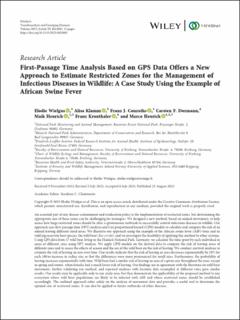First-Passage Time Analysis Based on GPS Data Offers a New Approach to Estimate Restricted Zones for the Management of Infectious Diseases in Wildlife: A Case Study Using the Example of African Swine Fever
Wielgus, Elodie; Klamm, Alisa; Conraths, Franz J.; Dormann, Carsten F.; Henrich, Maik; Kronthaler, Franz; Heurich, Marco Dietmar
Peer reviewed, Journal article
Published version
Permanent lenke
https://hdl.handle.net/11250/3121998Utgivelsesdato
2023Metadata
Vis full innførselSamlinger
Sammendrag
An essential part of any disease containment and eradication policy is the implementation of restricted zones, but determining the appropriate size of these zones can be challenging for managers. We designed a new method, based on animal movement, to help assess how large restricted zones should be after a spontaneous outbreak to successfully control infectious diseases in wildlife. Our approach uses first-passage time (FPT) analysis and Cox proportional hazard (CPH) models to calculate and compare the risk of an animal leaving different-sized areas. We illustrate our approach using the example of the African swine fever (ASF) virus and its wild pig reservoir host species, the wild boar (Sus scrofa), and we investigate the feasibility of applying this method to other systems. Using GPS data from 57 wild boar living in the Hainich National Park, Germany, we calculate the time spent by each individual in areas of different sizes using FPT analysis. We apply CPH models on the derived data to compare the risk of leaving areas of different sizes and to assess the effects of season and the sex of the wild boar on the risk of leaving. We conduct survival analyses to estimate the risk of leaving an area over time. Our results indicate that the risk of leaving an area decreases exponentially by 10% for each 100 m increase in radius size so that the differences were more pronounced for small sizes. Furthermore, the probability of leaving increases exponentially with time. Wild boar had a similar risk of leaving an area of a given size throughout the year, except in spring and winter, when females had a much lower risk of leaving. Our findings are in agreement with the literature on wild boar movement, further validating our method, and repeated analyses with location data resampled at different rates gave similar results. Our results may be applicable only to our study area, but they demonstrate the applicability of the proposed method to any ecosystem where wild boar populations are likely to be infected with ASF and where restricted zones should be established accordingly. The outlined approach relies solely on the analysis of movement data and provides a useful tool to determine the optimal size of restricted zones. It can also be applied to future outbreaks of other diseases.

